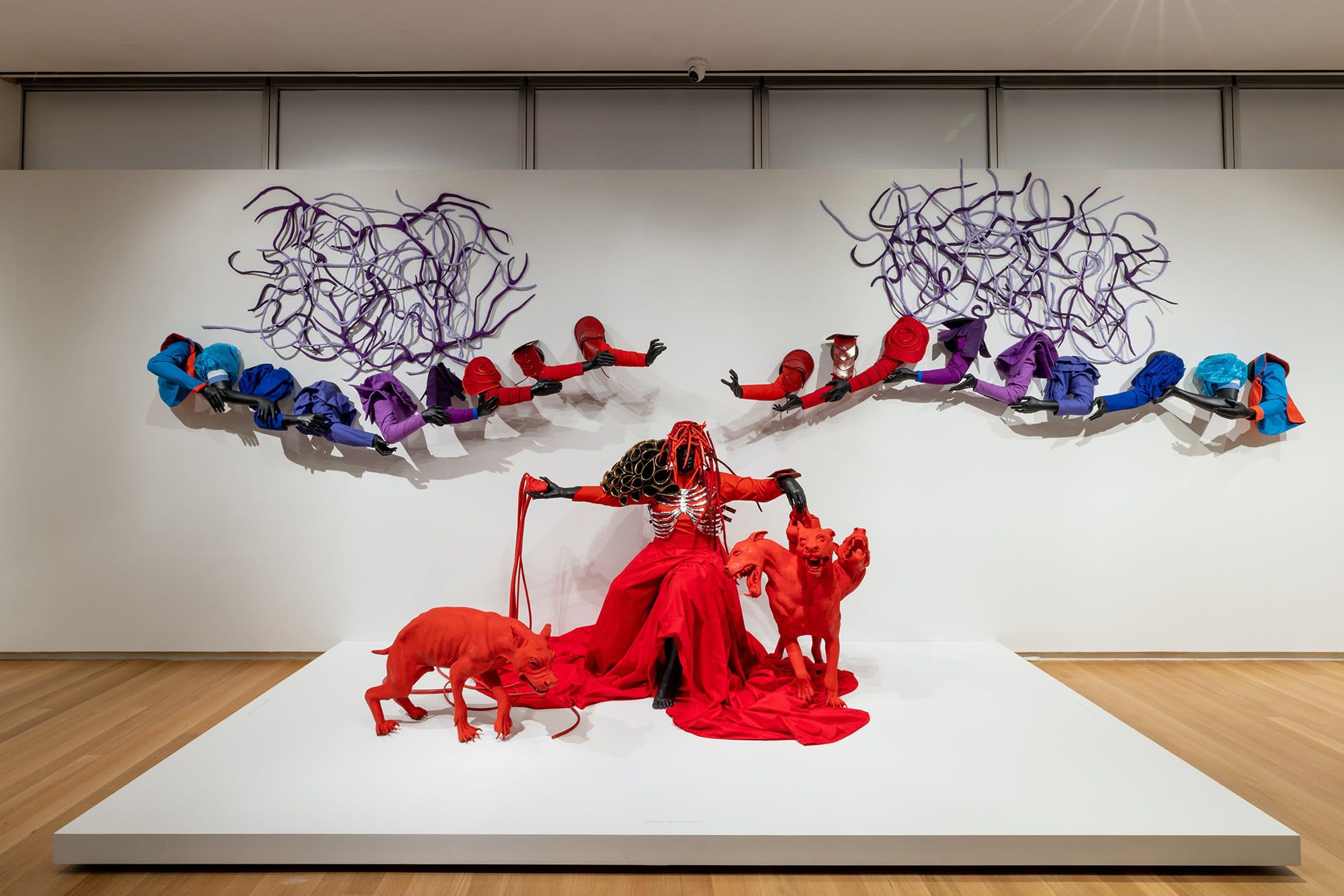
Garmenting: Costume as Contemporary Art is an ambitious exhibition that occupies two floors of the Museum of Art and Design. Curated by independent scholar Alexandra Schwartz, this show is long overdue for several reasons. First, it was long delayed by the COVID-19 shutdown; second, it presents overdue research into the blurred boundaries between art, performance, and fashion and includes a diverse group of artists into this discussion. While fashion and art have been symbiotic disciplines for centuries—think of Schiaparelli’s Dali lobster print, Yves Saint Laurent’s Piet Mondrian and Tom Wesselmann dresses, or Dior’s recent collaboration with Judy Chicago—the niche of performative garment as contemporary art rather than cyclical fashion has yet to be given appropriate shrift. Schwartz has created a memorable exhibition with works that confront significant global issues, including gender normativity and LGBTQ rights, police brutality, and domestic violence.
The show is divided into five sections, each of which could be a unique exhibition: “Functionality,” “Gender,” “Activism,” “Cultural Difference,” and “Performance.” Each section comprises a mix of household names with emerging artists. For example, the viewer encounters Louise Bourgeois’s large installation Blue Days (1996) when emerging from the elevator on the fourth floor. Here seven garments and a small red sphere are suspended, seemingly orbiting the axis of a central metal infrastructure. In typical Bourgeois style, the clothes are stand-ins for the female body and the domestic trauma often inflicted upon and carried by it. In addition, pieces by well-known artists Beverly Semmes, Franz Erhard Walther, Sylvie Fleury, and Annette Messager are hung in this section, titled “Functionality.” The inclusion of Hair (2011), a sculpture resembling a dress made of artificial hair extensions—a staple of current beauty standards—by Indian artist Vivan Sunderam, is more than just a ponderance on the functional; it’s appropriation of material is also a comment on India’s neoliberal economy, in which the division between rich and poor is further exacerbated. Likewise, Brazilian artist Nazareth Pacheco’s Untitled (2000) is an exoskeleton of a skirt made of beaded pearls with nefarious blades hanging at its hem. The artist, who underwent several medical and cosmetic surgeries to correct a congenital condition, speaks volumes about suffering for a Western idealized beauty in this work.

Mary Sibande, The Domba Dance, 2019. Life-size fiberglass, bronze, cotton, and silicone, 157 1/2 x 98 x 118 1/8 in. Courtesy of The Brooklyn Rail.
Also on the fourth floor, the “Cultural Difference” section offers a vibrant and exciting array of artworks. From Devan Shimoyama’s flowered and bejeweled sweatshirt,February II (2019) (an homage to Trayvon Martin), Nick Cave’s “Soundsuits” and Sanford Biggers’s quilted cape, Cape 3—Moonrising (Kennedy Center 4/4/19) (2019) to Yinka Shonibare’s Dutch wax textile-clad ghostlike figure, The Ghost of Eliza Jumel (2015), this part of the exhibition features patterns and colors that clash to spectacular effect, despite some of the darker themes. Mary Sibande’s The Domba Dance (2019) is a showstopping installation depicting a central female figure in a red gown, with arms outstretched. She is flanked by multi-headed and seemingly vicious dogs, leashed to her via what read as veins emerging from an anatomical heart. Above this a tableau of colorfully dressed shoulders and arms emerge from the wall. The artist based the work on a South African Tshivenda initiation ceremony in which young women transition into adulthood. As is the case with many works in this exhibition, such as Blue Days, The Domba Dance could also sit well in the “Gender” section.
On the third floor, in “Gender,” there is a balance between playfulness and solemnity, seen poignantly in Zoë Buckman’s large installation in which the artist embroidered hip hop lyrics on vintage lingerie. With individual titles like Bitch Again, Mama Don’t Cry and Prostitute Found Slain, all from 2016, the artist is paying tribute to her youthful adoration of this musical genre; yet, as a feminist woman, she has grown more skeptical of some of the lyrics, which often glorify violence towards women. Adjacent to Buckman’s installation, two gowns by Esmaa Mohamoud (with technical assistance from Qendrim Hoti) combine ballroom style hoopskirts with basketball jersey tops, subverting the assumed Black male masculinity of athletic clothing. These were worn by both male and female models when they were debuted at the Art Gallery of Ontario.
Raùl de Nieves’s Celebratory/Skin Knowledge (2019) continues the drag aesthetic with an artwork created from traditional Latin American sewing and beading techniques and can be read in conjunction with Hunter Reynolds’s Patina du Prey’s Drag Pose Cage (Simon Watson Gallery) (1990). Here a blue ball dress worn by the artist is suspended from the ceiling in the cage in which he once performed. Patina was Reynolds’s drag alter ego. Inspired by the gender fluidity of the club scene at the time, the performance didn’t translate effortlessly into the art world. Located adjacent to the “Performance” section of the exhibition, which includes garments, photo documentation and projected videos, Reynolds’s work, as well as many more in the exhibition, signals the interlocution of art, performance, and fashion in this rich and entertaining show.




